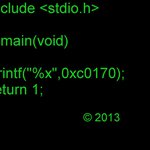The official Mbed 2 C/C++ SDK provides the software platform and libraries to build your applications.
Dependents: hello SerialTestv11 SerialTestv12 Sierpinski ... more
mbed 2
This is the mbed 2 library. If you'd like to learn about Mbed OS please see the mbed-os docs.
TARGET_SAMR21G18A/TOOLCHAIN_ARM_MICRO/dma.h
- Committer:
- AnnaBridge
- Date:
- 2019-02-20
- Revision:
- 172:65be27845400
- Parent:
- 171:3a7713b1edbc
File content as of revision 172:65be27845400:
/**
* \file
*
* \brief SAM Direct Memory Access Controller Driver
*
* Copyright (C) 2014-2015 Atmel Corporation. All rights reserved.
*
* \asf_license_start
*
* \page License
*
* Redistribution and use in source and binary forms, with or without
* modification, are permitted provided that the following conditions are met:
*
* 1. Redistributions of source code must retain the above copyright notice,
* this list of conditions and the following disclaimer.
*
* 2. Redistributions in binary form must reproduce the above copyright notice,
* this list of conditions and the following disclaimer in the documentation
* and/or other materials provided with the distribution.
*
* 3. The name of Atmel may not be used to endorse or promote products derived
* from this software without specific prior written permission.
*
* 4. This software may only be redistributed and used in connection with an
* Atmel microcontroller product.
*
* THIS SOFTWARE IS PROVIDED BY ATMEL "AS IS" AND ANY EXPRESS OR IMPLIED
* WARRANTIES, INCLUDING, BUT NOT LIMITED TO, THE IMPLIED WARRANTIES OF
* MERCHANTABILITY, FITNESS FOR A PARTICULAR PURPOSE AND NON-INFRINGEMENT ARE
* EXPRESSLY AND SPECIFICALLY DISCLAIMED. IN NO EVENT SHALL ATMEL BE LIABLE FOR
* ANY DIRECT, INDIRECT, INCIDENTAL, SPECIAL, EXEMPLARY, OR CONSEQUENTIAL
* DAMAGES (INCLUDING, BUT NOT LIMITED TO, PROCUREMENT OF SUBSTITUTE GOODS
* OR SERVICES; LOSS OF USE, DATA, OR PROFITS; OR BUSINESS INTERRUPTION)
* HOWEVER CAUSED AND ON ANY THEORY OF LIABILITY, WHETHER IN CONTRACT,
* STRICT LIABILITY, OR TORT (INCLUDING NEGLIGENCE OR OTHERWISE) ARISING IN
* ANY WAY OUT OF THE USE OF THIS SOFTWARE, EVEN IF ADVISED OF THE
* POSSIBILITY OF SUCH DAMAGE.
*
* \asf_license_stop
*
*/
/*
* Support and FAQ: visit <a href="http://www.atmel.com/design-support/">Atmel Support</a>
*/
#ifndef DMA_H_INCLUDED
#define DMA_H_INCLUDED
#ifdef __cplusplus
extern "C" {
#endif
/**
* \defgroup asfdoc_sam0_dma_group SAM Direct Memory Access Controller Driver (DMAC)
*
* This driver for Atmel® | SMART SAM devices provides an interface for the configuration
* and management of the Direct Memory Access Controller(DMAC) module within
* the device. The DMAC can transfer data between memories and peripherals, and
* thus off-load these tasks from the CPU. The module supports peripheral to
* peripheral, peripheral to memory, memory to peripheral, and memory to memory
* transfers.
*
* The following peripherals are used by the DMAC Driver:
* - DMAC (Direct Memory Access Controller)
*
* The following devices can use this module:
* - Atmel | SMART SAM D21
* - Atmel | SMART SAM R21
* - Atmel | SMART SAM D10/D11
* - Atmel | SMART SAM L21
* - Atmel | SMART SAM DAx
* - Atmel | SMART SAM C20/C21
*
* The outline of this documentation is as follows:
* - \ref asfdoc_sam0_dma_prerequisites
* - \ref asfdoc_sam0_dma_module_overview
* - \ref asfdoc_sam0_dma_special_considerations
* - \ref asfdoc_sam0_dma_extra_info
* - \ref asfdoc_sam0_dma_examples
* - \ref asfdoc_sam0_dma_api_overview
*
*
* \section asfdoc_sam0_dma_prerequisites Prerequisites
*
* There are no prerequisites for this module.
*
*
* \section asfdoc_sam0_dma_module_overview Module Overview
*
* SAM devices with DMAC enables high data transfer rates with minimum
* CPU intervention and frees up CPU time. With access to all peripherals,
* the DMAC can handle automatic transfer of data to/from modules.
* It supports static and incremental addressing for both source and
* destination.
*
* The DMAC when used with Event System or peripheral triggers, provides a
* considerable advantage by reducing the power consumption and performing
* data transfer in the background.
* For example if the ADC is configured to generate an event, it can trigger
* the DMAC to transfer the data into another peripheral or into SRAM.
* The CPU can remain in sleep during this time to reduce power consumption.
*
* <table>
* <tr>
* <th>Device</th>
* <th>Dma channel number</th>
* </tr>
* <tr>
* <td>SAMD21/R21/C20/C21</td>
* <td>12</td>
* </tr>
* <tr>
* <td>SAMD10/D11</td>
* <td>6</td>
* </tr>
* <tr>
* <td>SAML21</td>
* <td>16</td>
* </tr>
* </table>
* The DMA channel operation can be suspended at any time by software, by events
* from event system, or after selectable descriptor execution. The operation
* can be resumed by software or by events from event system.
* The DMAC driver for SAM supports four types of transfers such as
* peripheral to peripheral, peripheral to memory, memory to peripheral, and
* memory to memory.
*
* The basic transfer unit is a beat which is defined as a single bus access.
* There can be multiple beats in a single block transfer and multiple block
* transfers in a DMA transaction.
* DMA transfer is based on descriptors, which holds transfer properties
* such as the source and destination addresses, transfer counter, and other
* additional transfer control information.
* The descriptors can be static or linked. When static, a single block transfer
* is performed. When linked, a number of transfer descriptors can be used to
* enable multiple block transfers within a single DMA transaction.
*
* The implementation of the DMA driver is based on the idea that DMA channel
* is a finite resource of entities with the same abilities. A DMA channel resource
* is able to move a defined set of data from a source address to destination
* address triggered by a transfer trigger. On the SAM devices there are 12
* DMA resources available for allocation. Each of these DMA resources can trigger
* interrupt callback routines and peripheral events.
* The other main features are
*
* - Selectable transfer trigger source
* - Software
* - Event System
* - Peripheral
* - Event input and output is supported for the four lower channels
* - Four level channel priority
* - Optional interrupt generation on transfer complete, channel error or channel suspend
* - Supports multi-buffer or circular buffer mode by linking multiple descriptors
* - Beat size configurable as 8-bit, 16-bit, or 32-bit
*
* A simplified block diagram of the DMA Resource can be seen in
* \ref asfdoc_sam0_dma_module_block_diagram "the figure below".
*
* \anchor asfdoc_sam0_dma_module_block_diagram
* \dot
* digraph overview {
* splines = false;
* rankdir=LR;
*
* mux1 [label="Transfer Trigger", shape=box];
*
* dma [label="DMA Channel", shape=polygon, sides=6, orientation=60, style=filled, fillcolor=darkolivegreen1, height=1, width=1];
* descriptor [label="Transfer Descriptor", shape=box, style=filled, fillcolor=lightblue];
*
* mux1 -> dma;
* descriptor -> dma;
*
* interrupt [label="Interrupt", shape=box];
* events [label="Events", shape=box];
*
* dma:e -> interrupt:w;
* dma:e -> events:w;
*
* {rank=same; descriptor dma}
*
* }
* \enddot
*
* \subsection asfdoc_sam0_dma_features Driver Feature Macro Definition
* <table>
* <tr>
* <th>Driver Feature Macro</th>
* <th>Supported devices</th>
* </tr>
* <tr>
* <td>FEATURE_DMA_CHANNEL_STANDBY</td>
* <td>SAML21/C20/C21</td>
* </tr>
* </table>
* \note The specific features are only available in the driver when the
* selected device supports those features.
*
* \subsection asfdoc_sam0_dma_module_overview_dma_transf_term Terminology Used in DMAC Transfers
*
* <table border="0" cellborder="1" cellspacing="0" >
* <tr>
* <th> Name </th> <th> Description </th>
* </tr>
* <tr>
* <td > Beat </td>
* <td > It is a single bus access by the DMAC.
* Configurable as 8-bit, 16-bit, or 32-bit
* </td>
* </tr>
* <tr>
* <td > Burst </td>
* <td> It is a transfer of n-beats (n=1,4,8,16).
* For the DMAC module in SAM, the burst size is one beat.
* Arbitration takes place each time a burst transfer is completed
* </td>
* </tr>
* <tr>
* <td > Block transfer </td>
* <td> A single block transfer is a configurable number of (1 to 64k)
* beat transfers
* </td>
* </tr>
* </table>
*
* \subsection asfdoc_sam0_dma_module_overview_dma_channels DMA Channels
* The DMAC in each device consists of several DMA channels, which
* along with the transfer descriptors defines the data transfer properties.
* - The transfer control descriptor defines the source and destination
* addresses, source and destination address increment settings, the
* block transfer count and event output condition selection
* - Dedicated channel registers control the peripheral trigger source,
* trigger mode settings, event input actions, and channel priority level
* settings
*
* With a successful DMA resource allocation, a dedicated
* DMA channel will be assigned. The channel will be occupied until the
* DMA resource is freed. A DMA resource handle is used to identify the specific
* DMA resource.
* When there are multiple channels with active requests, the arbiter prioritizes
* the channels requesting access to the bus.
*
* \subsection asfdoc_sam0_dma_module_overview_dma_trigger DMA Triggers
* DMA transfer can be started only when a DMA transfer request is acknowledged/granted by the arbiter. A
* transfer request can be triggered from software, peripheral, or an event. There
* are dedicated source trigger selections for each DMA channel usage.
*
* \subsection asfdoc_sam0_dma_module_overview_dma_transfer_descriptor DMA Transfer Descriptor
* The transfer descriptor resides in the SRAM and
* defines these channel properties.
* <table border="0" cellborder="1" cellspacing="0" >
* <tr>
* <th> Field name </th> <th> Field width </th>
* </tr>
* <tr>
* <td > Descriptor Next Address </td> <td > 32 bits </td>
* </tr>
* <tr>
* <td > Destination Address </td> <td> 32 bits </td>
* </tr>
* <tr>
* <td > Source Address </td> <td> 32 bits </td>
* </tr>
* <tr>
* <td > Block Transfer Counter </td> <td> 16 bits </td>
* </tr>
* <tr>
* <td > Block Transfer Control </td> <td> 16 bits </td>
* </tr>
* </table>
*
* Before starting a transfer, at least one descriptor should be configured.
* After a successful allocation of a DMA channel, the transfer descriptor can
* be added with a call to \ref dma_add_descriptor(). If there is a transfer
* descriptor already allocated to the DMA resource, the descriptor will
* be linked to the next descriptor address.
*
* \subsection asfdoc_sam0_dma_module_overview_dma_output DMA Interrupts/Events
* Both an interrupt callback and an peripheral event can be triggered by the
* DMA transfer. Three types of callbacks are supported by the DMA driver:
* transfer complete, channel suspend, and transfer error. Each of these callback
* types can be registered and enabled for each channel independently through
* the DMA driver API.
*
* The DMAC module can also generate events on transfer complete. Event
* generation is enabled through the DMA channel, event channel configuration,
* and event user multiplexing is done through the events driver.
*
* The DMAC can generate events in the below cases:
*
* - When a block transfer is complete
*
* - When each beat transfer within a block transfer is complete
*
* \section asfdoc_sam0_dma_special_considerations Special Considerations
*
* There are no special considerations for this module.
*
*
* \section asfdoc_sam0_dma_extra_info Extra Information
*
* For extra information, see \ref asfdoc_sam0_dma_extra. This includes:
* - \ref asfdoc_sam0_dma_extra_acronyms
* - \ref asfdoc_sam0_dma_extra_dependencies
* - \ref asfdoc_sam0_dma_extra_errata
* - \ref asfdoc_sam0_dma_extra_history
*
*
* \section asfdoc_sam0_dma_examples Examples
*
* For a list of examples related to this driver, see
* \ref asfdoc_sam0_dma_exqsg.
*
*
* \section asfdoc_sam0_dma_api_overview API Overview
* @{
*/
#include <compiler.h>
#include "conf_dma.h"
#if (SAML21) || (SAMC20) || (SAMC21) || defined(__DOXYGEN__)
#define FEATURE_DMA_CHANNEL_STANDBY
#endif
/** DMA invalid channel number. */
#define DMA_INVALID_CHANNEL 0xff
/** ExInitial description section. */
extern DmacDescriptor descriptor_section[CONF_MAX_USED_CHANNEL_NUM];
/* DMA channel interrup flag. */
extern uint8_t g_chan_interrupt_flag[CONF_MAX_USED_CHANNEL_NUM];
/** DMA priority level. */
enum dma_priority_level {
/** Priority level 0. */
DMA_PRIORITY_LEVEL_0,
/** Priority level 1. */
DMA_PRIORITY_LEVEL_1,
/** Priority level 2. */
DMA_PRIORITY_LEVEL_2,
/** Priority level 3. */
DMA_PRIORITY_LEVEL_3,
};
/** DMA input actions. */
enum dma_event_input_action {
/** No action. */
DMA_EVENT_INPUT_NOACT,
/** Normal transfer and periodic transfer trigger. */
DMA_EVENT_INPUT_TRIG,
/** Conditional transfer trigger. */
DMA_EVENT_INPUT_CTRIG,
/** Conditional block transfer. */
DMA_EVENT_INPUT_CBLOCK,
/** Channel suspend operation. */
DMA_EVENT_INPUT_SUSPEND,
/** Channel resume operation. */
DMA_EVENT_INPUT_RESUME,
/** Skip next block suspend action. */
DMA_EVENT_INPUT_SSKIP,
};
/**
* Address increment step size. These bits select the address increment step
* size. The setting apply to source or destination address, depending on
* STEPSEL setting.
*/
enum dma_address_increment_stepsize {
/** The address is incremented by (beat size * 1). */
DMA_ADDRESS_INCREMENT_STEP_SIZE_1 = 0,
/** The address is incremented by (beat size * 2). */
DMA_ADDRESS_INCREMENT_STEP_SIZE_2,
/** The address is incremented by (beat size * 4). */
DMA_ADDRESS_INCREMENT_STEP_SIZE_4,
/** The address is incremented by (beat size * 8). */
DMA_ADDRESS_INCREMENT_STEP_SIZE_8,
/** The address is incremented by (beat size * 16). */
DMA_ADDRESS_INCREMENT_STEP_SIZE_16,
/** The address is incremented by (beat size * 32). */
DMA_ADDRESS_INCREMENT_STEP_SIZE_32,
/** The address is incremented by (beat size * 64). */
DMA_ADDRESS_INCREMENT_STEP_SIZE_64,
/** The address is incremented by (beat size * 128). */
DMA_ADDRESS_INCREMENT_STEP_SIZE_128,
};
/**
* DMA step selection. This bit determines whether the step size setting
* is applied to source or destination address.
*/
enum dma_step_selection {
/** Step size settings apply to the destination address. */
DMA_STEPSEL_DST = 0,
/** Step size settings apply to the source address. */
DMA_STEPSEL_SRC,
};
/** The basic transfer unit in DMAC is a beat, which is defined as a
* single bus access. Its size is configurable and applies to both read
* and write. */
enum dma_beat_size {
/** 8-bit access. */
DMA_BEAT_SIZE_BYTE = 0,
/** 16-bit access. */
DMA_BEAT_SIZE_HWORD,
/** 32-bit access. */
DMA_BEAT_SIZE_WORD,
};
/**
* Block action definitions.
*/
enum dma_block_action {
/** No action. */
DMA_BLOCK_ACTION_NOACT = 0,
/** Channel in normal operation and sets transfer complete interrupt flag
* after block transfer. */
DMA_BLOCK_ACTION_INT,
/** Trigger channel suspend after block transfer and sets channel
* suspend interrupt flag once the channel is suspended. */
DMA_BLOCK_ACTION_SUSPEND,
/** Sets transfer complete interrupt flag after a block transfer and
* trigger channel suspend. The channel suspend interrupt flag will be set
* once the channel is suspended. */
DMA_BLOCK_ACTION_BOTH,
};
/** Event output selection. */
enum dma_event_output_selection {
/** Event generation disable. */
DMA_EVENT_OUTPUT_DISABLE = 0,
/** Event strobe when block transfer complete. */
DMA_EVENT_OUTPUT_BLOCK,
/** Event output reserved. */
DMA_EVENT_OUTPUT_RESERVED,
/** Event strobe when beat transfer complete. */
DMA_EVENT_OUTPUT_BEAT,
};
/** DMA trigger action type. */
enum dma_transfer_trigger_action {
/** Perform a block transfer when triggered. */
DMA_TRIGGER_ACTON_BLOCK = DMAC_CHCTRLB_TRIGACT_BLOCK_Val,
/** Perform a beat transfer when triggered. */
DMA_TRIGGER_ACTON_BEAT = DMAC_CHCTRLB_TRIGACT_BEAT_Val,
/** Perform a transaction when triggered. */
DMA_TRIGGER_ACTON_TRANSACTION = DMAC_CHCTRLB_TRIGACT_TRANSACTION_Val,
};
/**
* Callback types for DMA callback driver.
*/
enum dma_callback_type {
/** Callback for any of transfer errors. A transfer error is flagged
* if a bus error is detected during an AHB access or when the DMAC
* fetches an invalid descriptor. */
DMA_CALLBACK_TRANSFER_ERROR,
/** Callback for transfer complete. */
DMA_CALLBACK_TRANSFER_DONE,
/** Callback for channel suspend. */
DMA_CALLBACK_CHANNEL_SUSPEND,
/** Number of available callbacks. */
DMA_CALLBACK_N,
};
/**
* DMA transfer descriptor configuration. When the source or destination address
* increment is enabled, the addresses stored into the configuration structure
* must correspond to the end of the transfer.
*
*/
struct dma_descriptor_config {
/** Descriptor valid flag used to identify whether a descriptor is
valid or not. */
bool descriptor_valid;
/** This is used to generate an event on specific transfer action in
a channel. Supported only in four lower channels. */
enum dma_event_output_selection event_output_selection;
/** Action taken when a block transfer is completed. */
enum dma_block_action block_action;
/** Beat size is configurable as 8-bit, 16-bit, or 32-bit. */
enum dma_beat_size beat_size;
/** Used for enabling the source address increment. */
bool src_increment_enable;
/** Used for enabling the destination address increment. */
bool dst_increment_enable;
/** This bit selects whether the source or destination address is
using the step size settings. */
enum dma_step_selection step_selection;
/** The step size for source/destination address increment.
The next address is calculated
as next_addr = addr + (2^step_size * beat size). */
enum dma_address_increment_stepsize step_size;
/** It is the number of beats in a block. This count value is
* decremented by one after each beat data transfer. */
uint16_t block_transfer_count;
/** Transfer source address. */
uint32_t source_address;
/** Transfer destination address. */
uint32_t destination_address;
/** Set to zero for static descriptors. This must have a valid memory
address for linked descriptors. */
uint32_t next_descriptor_address;
};
/** Configurations for DMA events. */
struct dma_events_config {
/** Event input actions. */
enum dma_event_input_action input_action;
/** Enable DMA event output. */
bool event_output_enable;
};
/** DMA configurations for transfer. */
struct dma_resource_config {
/** DMA transfer priority. */
enum dma_priority_level priority;
/**DMA peripheral trigger index. */
uint8_t peripheral_trigger;
/** DMA trigger action. */
enum dma_transfer_trigger_action trigger_action;
#ifdef FEATURE_DMA_CHANNEL_STANDBY
/** Keep DMA channel enabled in standby sleep mode if true. */
bool run_in_standby;
#endif
/** DMA events configurations. */
struct dma_events_config event_config;
};
/** Forward definition of the DMA resource. */
struct dma_resource;
/** Type definition for a DMA resource callback function. */
typedef void (*dma_callback_t)(struct dma_resource *const resource);
/** Structure for DMA transfer resource. */
struct dma_resource {
/** Allocated DMA channel ID. */
uint8_t channel_id;
/** Array of callback functions for DMA transfer job. */
dma_callback_t callback[DMA_CALLBACK_N];
/** Bit mask for enabled callbacks. */
uint8_t callback_enable;
/** Status of the last job. */
volatile enum status_code job_status;
/** Transferred data size. */
uint32_t transfered_size;
/** DMA transfer descriptor. */
DmacDescriptor* descriptor;
};
/**
* \brief Get DMA resource status.
*
* \param[in] resource Pointer to the DMA resource
*
* \return Status of the DMA resource.
*/
static inline enum status_code dma_get_job_status(struct dma_resource *resource)
{
Assert(resource);
return resource->job_status;
}
/**
* \brief Check if the given DMA resource is busy.
*
* \param[in] resource Pointer to the DMA resource
*
* \return Status which indicates whether the DMA resource is busy.
*
* \retval true The DMA resource has an on-going transfer
* \retval false The DMA resource is not busy
*/
static inline bool dma_is_busy(struct dma_resource *resource)
{
Assert(resource);
return (resource->job_status == STATUS_BUSY);
}
/**
* \brief Enable a callback function for a dedicated DMA resource.
*
* \param[in] resource Pointer to the DMA resource
* \param[in] type Callback function type
*
*/
static inline void dma_enable_callback(struct dma_resource *resource,
enum dma_callback_type type)
{
Assert(resource);
resource->callback_enable |= 1 << type;
g_chan_interrupt_flag[resource->channel_id] |= (1UL << type);
}
/**
* \brief Disable a callback function for a dedicated DMA resource.
*
* \param[in] resource Pointer to the DMA resource
* \param[in] type Callback function type
*
*/
static inline void dma_disable_callback(struct dma_resource *resource,
enum dma_callback_type type)
{
Assert(resource);
resource->callback_enable &= ~(1 << type);
g_chan_interrupt_flag[resource->channel_id] &= (~(1UL << type) & DMAC_CHINTENSET_MASK);
DMAC->CHINTENCLR.reg = (1UL << type);
}
/**
* \brief Register a callback function for a dedicated DMA resource.
*
* There are three types of callback functions, which can be registered:
* - Callback for transfer complete
* - Callback for transfer error
* - Callback for channel suspend
*
* \param[in] resource Pointer to the DMA resource
* \param[in] callback Pointer to the callback function
* \param[in] type Callback function type
*
*/
static inline void dma_register_callback(struct dma_resource *resource,
dma_callback_t callback, enum dma_callback_type type)
{
Assert(resource);
resource->callback[type] = callback;
}
/**
* \brief Unregister a callback function for a dedicated DMA resource.
*
* There are three types of callback functions:
* - Callback for transfer complete
* - Callback for transfer error
* - Callback for channel suspend
*
* The application can unregister any of the callback functions which
* are already registered and are no longer needed.
*
* \param[in] resource Pointer to the DMA resource
* \param[in] type Callback function type
*
*/
static inline void dma_unregister_callback(struct dma_resource *resource,
enum dma_callback_type type)
{
Assert(resource);
resource->callback[type] = NULL;
}
/**
* \brief Will set a software trigger for resource.
*
* This function is used to set a software trigger on the DMA channel
* associated with resource. If a trigger is already pending no new trigger
* will be generated for the channel.
*
* \param[in] resource Pointer to the DMA resource
*/
static inline void dma_trigger_transfer(struct dma_resource *resource)
{
Assert(resource);
DMAC->SWTRIGCTRL.reg |= (1 << resource->channel_id);
}
/**
* \brief Initializes DMA transfer configuration with predefined default values.
*
* This function will initialize a given DMA descriptor configuration structure to
* a set of known default values. This function should be called on
* any new instance of the configuration structure before being
* modified by the user application.
*
* The default configuration is as follows:
* \li Set the descriptor as valid
* \li Disable event output
* \li No block action
* \li Set beat size as byte
* \li Enable source increment
* \li Enable destination increment
* \li Step size is applied to the destination address
* \li Address increment is beat size multiplied by 1
* \li Default transfer size is set to 0
* \li Default source address is set to NULL
* \li Default destination address is set to NULL
* \li Default next descriptor not available
* \param[out] config Pointer to the configuration
*
*/
static inline void dma_descriptor_get_config_defaults(struct dma_descriptor_config *config)
{
Assert(config);
/* Set descriptor as valid */
config->descriptor_valid = true;
/* Disable event output */
config->event_output_selection = DMA_EVENT_OUTPUT_DISABLE;
/* No block action */
config->block_action = DMA_BLOCK_ACTION_NOACT;
/* Set beat size to one byte */
config->beat_size = DMA_BEAT_SIZE_BYTE;
/* Enable source increment */
config->src_increment_enable = true;
/* Enable destination increment */
config->dst_increment_enable = true;
/* Step size is applied to the destination address */
config->step_selection = DMA_STEPSEL_DST;
/* Address increment is beat size multiplied by 1*/
config->step_size = DMA_ADDRESS_INCREMENT_STEP_SIZE_1;
/* Default transfer size is set to 0 */
config->block_transfer_count = 0;
/* Default source address is set to NULL */
config->source_address = (uint32_t)NULL;
/* Default destination address is set to NULL */
config->destination_address = (uint32_t)NULL;
/** Next descriptor address set to 0 */
config->next_descriptor_address = 0;
}
/**
* \brief Update DMA descriptor.
*
* This function can update the descriptor of an allocated DMA resource.
*
*/
static inline void dma_update_descriptor(struct dma_resource *resource,
DmacDescriptor* descriptor)
{
Assert(resource);
resource->descriptor = descriptor;
}
/**
* \brief Reset DMA descriptor.
*
* This function will clear the DESCADDR register of an allocated DMA resource.
*
*/
static inline void dma_reset_descriptor(struct dma_resource *resource)
{
Assert(resource);
resource->descriptor = NULL;
}
void dma_get_config_defaults(struct dma_resource_config *config);
enum status_code dma_allocate(struct dma_resource *resource,
struct dma_resource_config *config);
enum status_code dma_free(struct dma_resource *resource);
enum status_code dma_start_transfer_job(struct dma_resource *resource);
void dma_abort_job(struct dma_resource *resource);
void dma_suspend_job(struct dma_resource *resource);
void dma_resume_job(struct dma_resource *resource);
void dma_descriptor_create(DmacDescriptor* descriptor,
struct dma_descriptor_config *config);
enum status_code dma_add_descriptor(struct dma_resource *resource,
DmacDescriptor* descriptor);
/** @} */
/**
* \page asfdoc_sam0_dma_extra Extra Information for DMAC Driver
*
* \section asfdoc_sam0_dma_extra_acronyms Acronyms
* Below is a table listing the acronyms used in this module, along with their
* intended meanings.
*
* <table>
* <tr>
* <th>Acronym</th>
* <th>Description</th>
* </tr>
* <tr>
* <td>DMA</td>
* <td>Direct Memory Access</td>
* </tr>
* <tr>
* <td>DMAC</td>
* <td>Direct Memory Access Controller </td>
* </tr>
* <tr>
* <td>CPU</td>
* <td>Central Processing Unit</td>
* </tr>
* </table>
*
*
* \section asfdoc_sam0_dma_extra_dependencies Dependencies
* This driver has the following dependencies:
*
* - \ref asfdoc_sam0_system_clock_group "System Clock Driver"
*
*
* \section asfdoc_sam0_dma_extra_errata Errata
* There are no errata related to this driver.
*
*
* \section asfdoc_sam0_dma_extra_history Module History
* An overview of the module history is presented in the table below, with
* details on the enhancements and fixes made to the module since its first
* release. The current version of this corresponds to the newest version in
* the table.
*
* <table>
* <tr>
* <th>Changelog</th>
* </tr>
* <tr>
* <td>Add SAM C21 support</td>
* </tr>
* <tr>
* <td>Add SAM L21 support</td>
* </tr>
* <tr>
* <td>Initial Release</td>
* </tr>
* </table>
*/
/**
* \page asfdoc_sam0_dma_exqsg Examples for DMAC Driver
*
* This is a list of the available Quick Start Guides (QSGs) and example
* applications for \ref asfdoc_sam0_dma_group. QSGs are simple examples with
* step-by-step instructions to configure and use this driver in a selection of
* use cases. Note that QSGs can be compiled as a standalone application or be
* added to the user application.
*
* - \subpage asfdoc_sam0_dma_basic_use_case
*
* \note More DMA usage examples are available in peripheral QSGs.
* A quick start guide for TC/TCC
* shows the usage of DMA event trigger; SERCOM SPI/USART/I<SUP>2</SUP>C has example for
* DMA transfer from peripheral to memory or from memory to peripheral;
* ADC/DAC shows peripheral to peripheral transfer.
*
* \page asfdoc_sam0_dma_document_revision_history Document Revision History
*
* <table>
* <tr>
* <th>Doc. Rev.</td>
* <th>Date</td>
* <th>Comments</td>
* </tr>
* <tr>
* <td>C</td>
* <td>06/2015</td>
* <td>Added SAML21, SAMC21, and SAMDAx support</td>
* </tr>
* <tr>
* <td>B</td>
* <td>12/2014</td>
* <td>Added SAMR21 and SAMD10/D11 support</td>
* </tr>
* <tr>
* <td>A</td>
* <td>02/2014</td>
* <td>Initial release</td>
* </tr>
* </table>
*/
#ifdef __cplusplus
}
#endif
#endif /* DMA_H_INCLUDED */
 mbed official
mbed official




